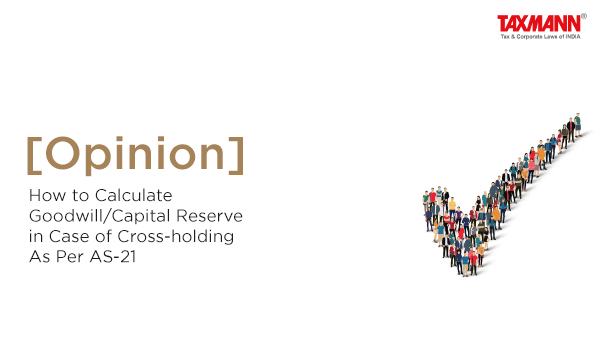[Opinion] How to Calculate Goodwill/Capital Reserve in Case of Cross-holding As Per AS-21
- Blog|News|Account & Audit|
- 2 Min Read
- By Taxmann
- |
- Last Updated on 4 January, 2024

CA Bharat Sonkhiya, CA Vikash Maharshi & Manasvi Rathi – [2024] 158 taxmann.com 60 (Article)
Introduction
This article explores the calculation of goodwill and capital reserve under various circumstances following the guidelines laid out in Accounting Standard 21. We’ll break down the complexities of the topic and understand the concept through definitions and examples.
Let’s begin with the first question that pops up in our minds!
What is goodwill and capital reserve and when is the need for the calculation of goodwill/capital reserve in the preparation of CFS?
Goodwill
Any excess of the cost to the parent of its investment in a subsidiary over the parent’s portion of equity of the subsidiary, at the date on which investment in the subsidiary is made is known as goodwill.
Goodwill represents the excess of the purchase price of an acquired subsidiary over the fair value of its identifiable net assets.
Capital Reserve
When the cost to the parent of its investment in a subsidiary is less than the parent’s portion of equity of the subsidiary, at the date on which investment in the subsidiary is made, the difference should be treated as a capital reserve in the consolidated financial statements.
The goodwill or capital reserve is calculated while preparing the consolidated financial statements on the acquisition of control over another company.
What is the need for forming consolidated financial statements?
Accounting Standard (AS) 21 states that consolidated financial statements combine financial information from parent and subsidiary entities.
A parent, usually referred to as a holding entity, presents consolidated financial statements to give financial details on the economic operations of its group.
These statements aim to demonstrate the economic resources held by the group, its commitments, and the outcomes the group attains with its resources by presenting financial information about a parent and its subsidiary as a unified economic entity.
Click Here To Read The Full Article
Disclaimer: The content/information published on the website is only for general information of the user and shall not be construed as legal advice. While the Taxmann has exercised reasonable efforts to ensure the veracity of information/content published, Taxmann shall be under no liability in any manner whatsoever for incorrect information, if any.

Taxmann Publications has a dedicated in-house Research & Editorial Team. This team consists of a team of Chartered Accountants, Company Secretaries, and Lawyers. This team works under the guidance and supervision of editor-in-chief Mr Rakesh Bhargava.
The Research and Editorial Team is responsible for developing reliable and accurate content for the readers. The team follows the six-sigma approach to achieve the benchmark of zero error in its publications and research platforms. The team ensures that the following publication guidelines are thoroughly followed while developing the content:
- The statutory material is obtained only from the authorized and reliable sources
- All the latest developments in the judicial and legislative fields are covered
- Prepare the analytical write-ups on current, controversial, and important issues to help the readers to understand the concept and its implications
- Every content published by Taxmann is complete, accurate and lucid
- All evidence-based statements are supported with proper reference to Section, Circular No., Notification No. or citations
- The golden rules of grammar, style and consistency are thoroughly followed
- Font and size that’s easy to read and remain consistent across all imprint and digital publications are applied



 CA | CS | CMA
CA | CS | CMA
